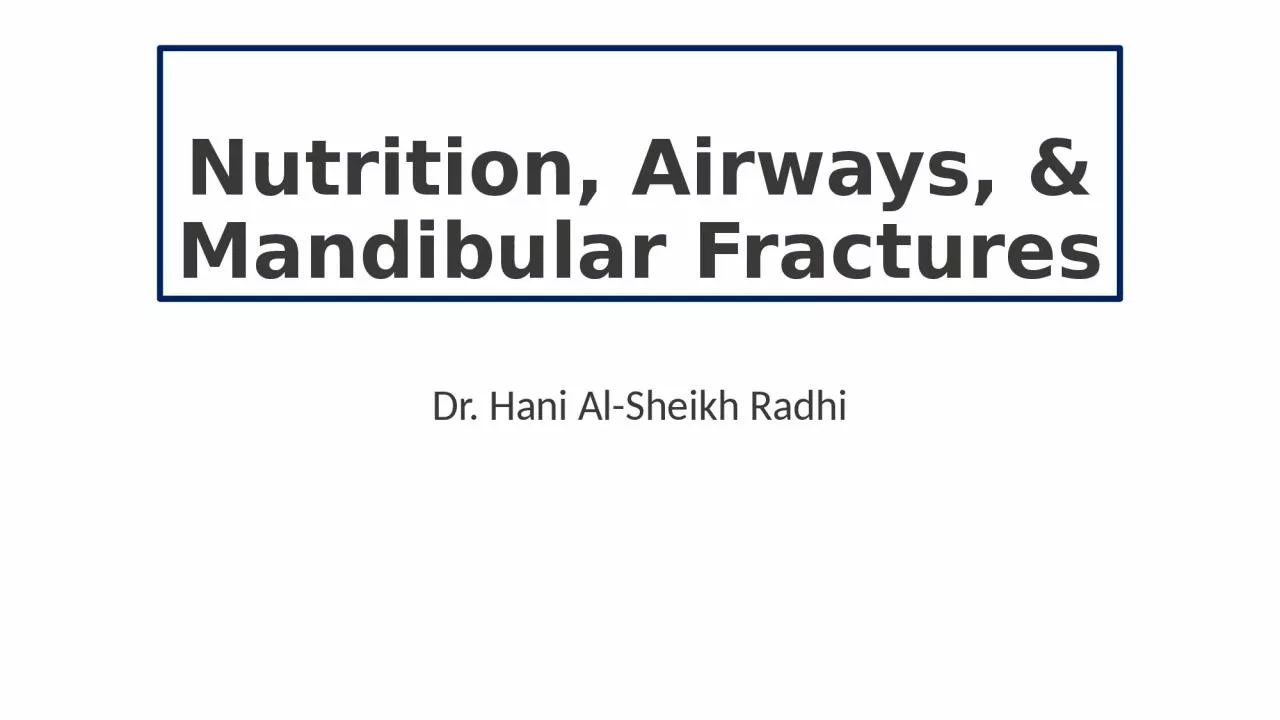

Dr Hani AlSheikh Radhi Nutrition Starvation 75 kg reservoir of 200000 cal Theoretically sustain the patient for 35 months Reality below 140000 cal Death can occur Body attempts to conserve energy resources and cellular function ID: 932447
Download Presentation The PPT/PDF document "Nutrition, Airways, & Mandibular Fra..." is the property of its rightful owner. Permission is granted to download and print the materials on this web site for personal, non-commercial use only, and to display it on your personal computer provided you do not modify the materials and that you retain all copyright notices contained in the materials. By downloading content from our website, you accept the terms of this agreement.
Slide1
Nutrition, Airways, & Mandibular Fractures
Dr. Hani Al-Sheikh Radhi
Slide2Nutrition
Starvation
75 kg reservoir of 200,000 cal. Theoretically sustain the patient for 3-5 months.
Reality below 140,000 cal. Death can occur.
Body attempts to conserve energy resources and cellular function
No exterior source of energy. The body will consume fat and muscles. (1kg of muscles will provide 800 cal, 1kg of fat will provide 7000 cal)
Hepatic and GIT systems will be first affected. Gradually drop in Glucose levels. After depletion the brain will depend on fat as source of energy.
Fat can’t cross the blood brain barrier it will be transformed into ketone acids to pass the barrier and that will create state of acidosis. Which can cause depression of the CNS and its function
Slide3Stress related starvation
Stress means trauma, burn, severe infection. Affect physiology of body
Neuroendocrine mediated process. Catabolism Process controlled by hormones (catecholamine, cortisol, and Glucagon) (Interleukins and Cytokines)
Result
HYPERMETABOLIC STATE
Increase temp., Increase in O2 consumption, Overactive circulation, decrease in insulin, decrease in body mass, lipolysis, increase lactate and pyruvate.
Neuroendocrine Starvation State
Peaks 48-72 hrs. Subside 3-4 days, result in severe loss of vitamins and minerals, severe malnutrition develops within days.
Slide4Hyper-metabolic state patient treated by metabolic support
Treatment is different than treating real starvation.
Assess Body Mass Index (BMI), Basic Energy Expenditure formula (BEE), Assess Urine Albumin and Nitrogen
Nitrogen in Urine is very important indicator to the levels of protein destruction. Which if positive indicates continuous state of muscular destruction hence continues state of hyper-metabolism.
All food contain hydrogen and oxygen but only proteins contain nitrogen
Treatment
: well nourished patient expected to be back on oral feeding within 1 week we give I.V. 5% Dextrose equivalent to 500 Kcal/day.
Treatment
: Bad nourishment, +/- more than 1 week before oral feeding we need alternative source of feeding.
Slide5Slide6NON-ORAL METHODS OF NUTRITIONAL THERAPY
NG Tube (Nasogastric feeding)
Tube inserted from the nose into the stomach
We give the patient
metocoplramide
, relax stomach sphincter pylorus
The tube can sustain the patient 4-6 weeks maximum.
Risk: patient with midface and skull base fractures, tracheostomy
Slide7Slide8NON-ORAL METHODS OF NUTRITIONAL THERAPY
PERCUTANEOUS ENDOSCOPIC GASTROSTOMY (PEG)
Old method named Gastrostomy.
No laparotomy, no scar, no peritoneal tearing, less infection risk
Immediate feeding with PEG, less post-op pain
Indication in OMFS,
Cnacer
H&N, Obstruction in pharynx and Larynx
Slide91. Initial assessment: Recognize airway obstruction.
2. Perform airway maneuvers, clear the airway, reposition patient
3. Use artificial airways, and perform bag-valve-mask ventilation
4. Perform endotracheal intubation.
5. Create a surgical airway if unable to intubate.Emergency Airway Management in the Traumatized Patient
Slide10Initial Assessment
Look
1- Patients with compromised airways sits up right.
2- Look of terror on their face.
3- Anxiety and agitation are signs of hypoxia.
4- Altered Level of consciousness are signs of hypercarbia.Listen
FeelQuick way: Ask the patient to describe the injury. If he was able to do it then he doesn’t require rapid airway intervention. Obstruction in the upper airway usually cause noisy breathing,
stridor,and
wheezing.
feel for facial fractures, soft tissue swelling, subcutaneous air in the neck, laryngeal tenderness, and dental injuries during the primary assessment
Slide11Maintain the patient’s airways
+ to the basic maneuvers
Oropharyngeal & Nasopharyngeal tubes
Temporary until definitive intubation
Oropharyngeal (OPA)Patients with no history no gagging
Determine the proper size and insertion method Nasopharyngeal (NPA)Patients with no history no gaggingDetermine the proper size and insertion method
Slide12Oropharyngeal (OPA)
Slide13Nasopharyngeal Airway(NPA)
Slide14BAG-VALVE-MASK (BVM) VENTILATION
Provides positive pressure
Used usually with other maneuvers
MOANS Difficulty Test (Mask, Obesity/obstruction, Age, No teeth, Stiffness [Asthma, COPD])
Used usually with other maneuvers
Slide15ENDOTRACHEAL INTUBATION
placement of a flexible plastic tube into the trachea to maintain an open airway
2 types: 1- Direct
Laryngeoscopy
2-
Nasotracheal IntubationIndications1- Apnea2- Hypoxia less than 90% SPo23- Inadequate Mask seal.
4- No patent airways.5-GCS less than 9.6- Unstable midface fracture.7- Shock BP less than 80 mmHg
Slide16Slide17Adjunct Medications
Premedication
I.V. Lidocaine (anesthesia)
Opioids (Analgesia)
Atropine (Decrease Secretions)
Etomidate
(Sedation)Succinylcholine (Muscle Relaxing)
Slide18SURGICAL AIRWAY
Slide19